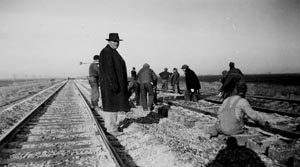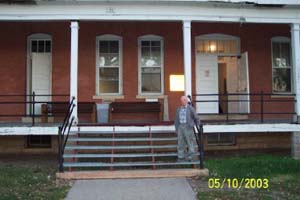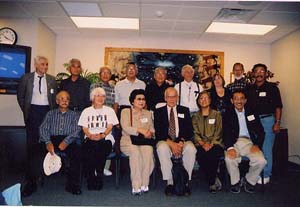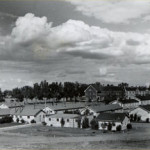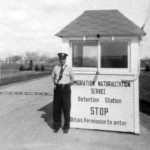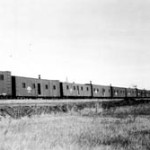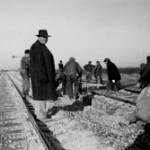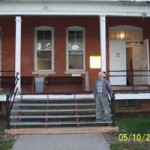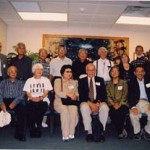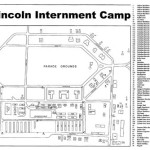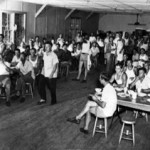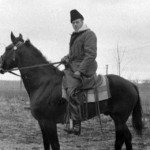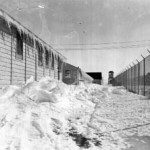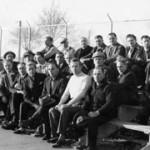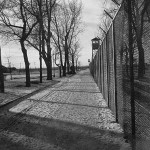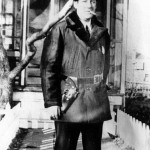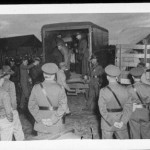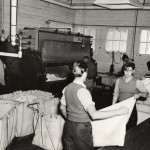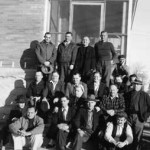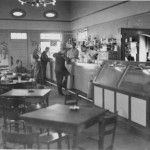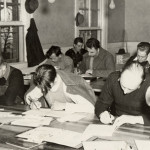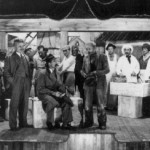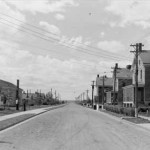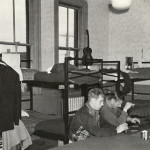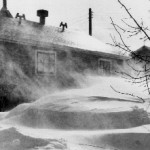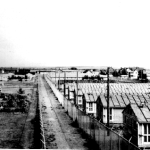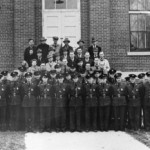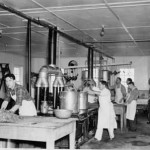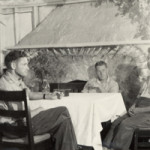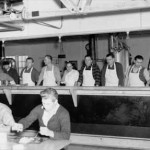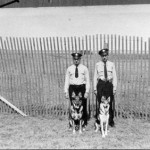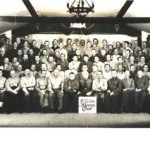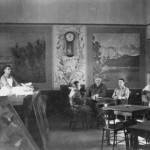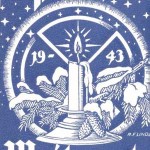Fort Lincoln, Bismarck, North Dakota
INTERNMENT CAMPS

Overview of Ft. Lincoln 1941—John Christgau Collection
History
Originally an Army military post, the brick buildings which remain on the site were built in from 1900-1910. In the 1930s, the Civilian Conservation Corps used Ft. Lincoln as its state headquarters and erected many prefabricated wooden buildings. During World War II, the facility was converted into a Department of Justice (“DOJ”) male enemy alien internment facility for use by the Immigration and Naturalization Service (“INS”) Ten foot double fences were erected around the facility and guard towers built. After the war, Ft. Lincoln served many governmental purposes, but in 1966 it was declared surplus. In 1969, it became the United Tribes Technical College. Today, the UTTC continues to use many of the buildings used to house, feed and administer the WWII internees.
Hundreds of German and Italian seamen were the first internees at Ft. Lincoln. They had served on German and Italian commercial ships which were impounded in US ports when the war started in Europe in 1939. Records indicate that the Italians were transferred to Fort Missoula, Montana, but the Germans remained. As German civilians were arrested and interned, many were interned at Ft. Lincoln. A large number arrived from Camp Forrest, an Army-run camp in Tullahoma, Tennessee, in May 1943, when that camp was converted into German POW camp. Later, in February 1945, approximately 650 Japanese men who had renounced their American citizenship were sent to the camp for eventual deportation to Japan. Other Japanese nationals followed. (See October 1945 inspection report.) (See 30 June 1945 census listing German American and Latin American internees.) The last internee left Ft. Lincoln in March 1946. By that time, 4,030 German and Japanese men had passed through its gates, including 2,150 Germans and 1,800 Japanese.
A stone gateway marks the college entrance along State Highway 1804, approximately ¼ mile south of the Bismarck Airport. Internees have visited the site over the years and struggle with long-suppressed emotions as they walk through the gates and stand in the buildings where they were incarcerated decades earlier. To date, no marker or memorial recognizes the fact that hundreds of men spent years interned at this site.
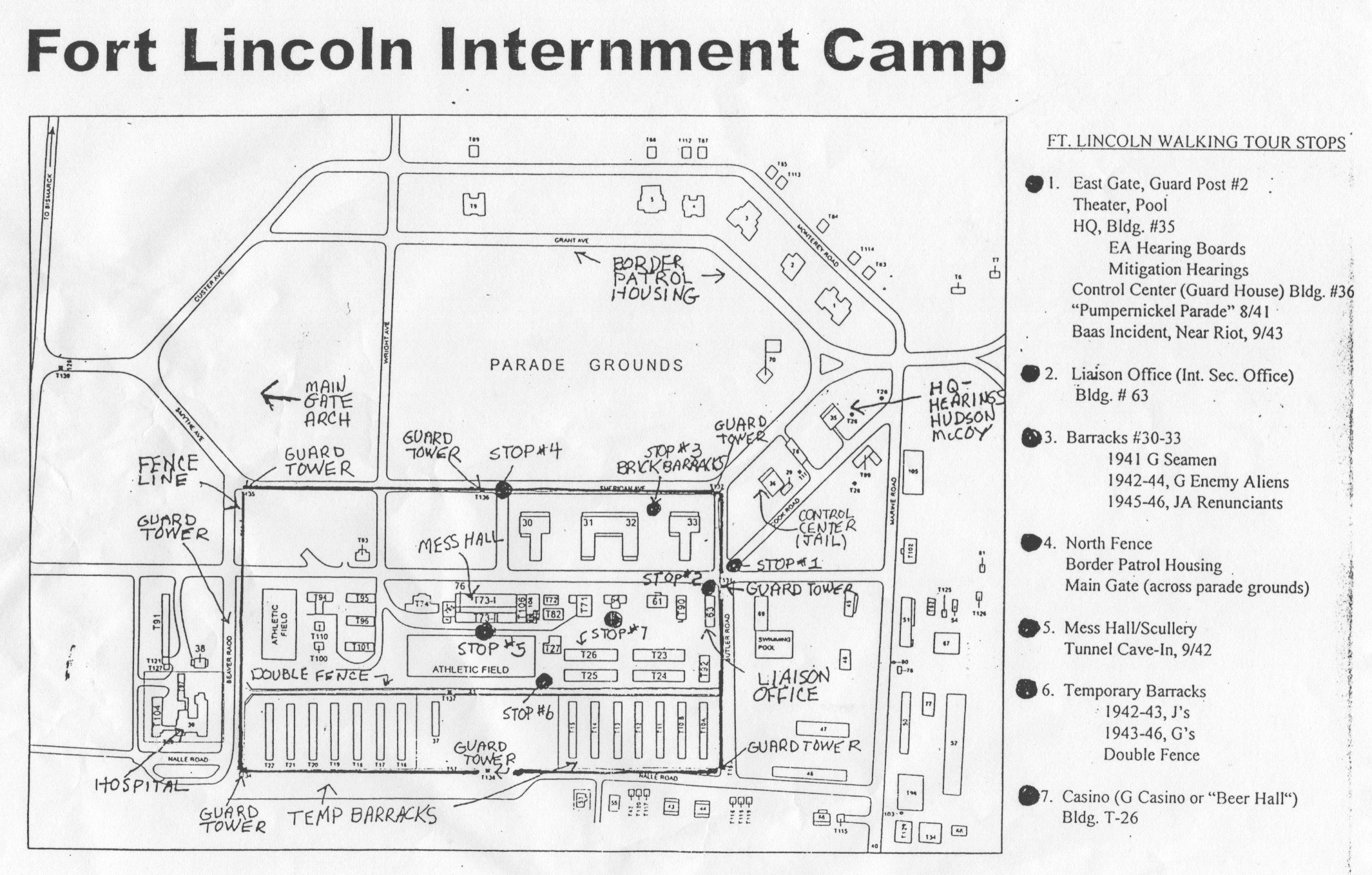
Ft. Lincoln map with walking tour stops
Ft. Lincoln served as the largest male internee camp during the World War II. The internees came from all over the country and Latin America, and from all walks of life. Most were middle-aged and engaged various trades. Few were professionals. Since there was no attempt to intern the men near their homes and families, many were thousands of miles from their loved ones who could not come to visit. As with all the camps, their only means of communication was through censored mail. Besides the emotional and financial trauma of internment, perhaps the biggest problem the men faced was simple boredom. Many engaged in athletic activities, such as soccer. Some were even allowed to construct a mini-ski ramp, while others played hockey during the long North Dakota winders. Others ran the canteen, helped in the kitchen and office, worked in the carpenter shop and helped maintain the camp. Those inclined toward the arts participated in theatre productions, choir, drew and pursued other handicrafts. Richard Kleifoth, a Costa Rican German, made block prints, four of which remain in the family of Heinrich Sauer, another former internee from New Jersey. (See Ft. Lincoln garden, view from the barracks, Heinrich Sauer, fence-gazing)

playing cards—courtesy Curt Haedke family
Max Ebel remembers a wrestling area built for the Japanese internees who enjoyed it tremendously. (He also remembers getting trounced by the one Japanese man with whom he wrestled.) Some spent long hours writing letters appealing their internment decisions and some tried, unsuccessfully, to escape by tunneling under the fences. (See rules governing the “German Camp” in Bulletin No. 9, English/German
The Railroaders – Northern Pacific Railroad
As the war dragged on, many men from North Dakota enlisted in the military, leaving a dearth of males to perform rugged railroad work. The Northern Pacific Railroad working through the State Department and the German government obtained permission to hire internees to work outside the camp. Originally, over 500 men signed on to do the work, but eventually only approximately 100 were selected to do the work. Tension ran high among the internees who had very mixed feelings about the railroad work which was perceived to be aiding the US war effort. Some, resenting their internment, vehemently opposed it and made life difficult for the railroaders. Some original volunteers withdrew, but many others refused to be denied their chance to escape life behind barbed wire, even if it was to do hard labor and live in boxcars during the hard North Dakota winter. Max Ebel, was among them.
The internees were carefully watched as they performed their duties. They lived 6-8 in a boxcar with a coal stove and bunks. Guards checked on them throughout the night and watched them during the day. The work trains stayed in several North Dakota towns adjoining the railroad: Casselton, Buffalo, Steele and Mandan, among them. The men also worked in and on rail lines in the Standing Rock Lakota Reservation near Cannonball where some befriended the poverty-stricken Native Americans.
After writing many letters, one railroader, representing his fellow workers, finally persuaded the Alien Enemy Control Unit of the Department of Justice to grant rehearings to the railroaders. Apparently, the argument that the men had shown good faith in working for the railroad, thereby helping the government, worked. Many men were granted rehearings in 1944 and thereafter and were paroled. Some suspect though that the rehearings permitted the government to draft some of the men out of the camps which also occurred.
Ft. Lincoln Today
The UTTC graciously hosted the first reunion to be held at Ft. Lincoln in conjunction with the opening of the North Dakota Museum of Art’s Snow Country Prison exhibit in October 2003. this exhibit was the first compendium of pictures of the camp, beautifully interspersed with haiku by a former Japanese internee, Itaru Ina. Former German and Japanese internees and their families returned to the camp to share an emotional weekend of memories—together.
To date, no marker or memorial acknowledges that this site was a government internment facility for thousands of innocent men during World War II.In 2010, GAIC, working with a consortium of partners, was granted funding from the National Park Service Japanese Confinement Grant Program, to begin the planning process for a memorial. A planning conference was held at the UTTC in May 2010. Read more in Current Events.
An excellent book on Ft. Lincoln during World War II, John Christgau’s Enemies—World War II Alien Enemy Internment, is the first to chronicle the internment of Germans during World War II. It was republished in 2009 by the University of Nebraska Press. For additional pictures and information on Enemies, please visit www.johnchristgau.com.
- Overview of Ft. Lincoln 1941 John Christgau Collection
- Guard house at Ft. Lincoln entrance—TRACES Collection
- Boxcar homes of the internee railroaders in North Dakota 1943 Max Ebel Collection
- Internees performing their duties 1943 Max Ebel Collection
- Max Ebel stands in front of Building L-33 where he lived, now a UTTC dormitory. October 2003.
- Former German and Japanese internees at Ft. Lincoln (with family). October 2003
- Map of Fort Lincoln circa 1944
- Meal time at Ft. Lincoln John Christgau Collection
- Mounted Border Patrol Guard at Ft. Lincoln. John Christgau Collection
- Winter inside the fence at Ft. Lincoln John Christgau Collection
- German Internees at Ft. Lincoln circa 1942 Ursula Vogt Potter Collection
- German Internees at Ft. Lincoln circa 1942 Ursula Vogt Potter Collection
- Inner fence line of double fence at Ft. Lincoln John Christgau Collection
- Border Patrol Camp Guard John Christgau Collection
- Internees arriving at Ft. Lincoln 1941 John Christgau Collection
- Others did the laundry. Some preferred this task because the laundry room was warm. TRACES Collection
- Germans internees pose for photo by one of the “dormitories.” 1942 Ursula Vogt Potter Collection
- German internees had an active theatre group. Guenther Greis Collection
- Camp Commander IP McCoy permitted the men to have a canteen… John Christgau Collection
- Still others studied, hoping one day to become US citizens. John Christgau Collection.
- German internees had an active theatre group. Guenther Greis Collection
- Street inside Ft. Lincoln Ursula Vogt Potter Collection
- Hours moved slowly for the internees. Here they play cards in the sleeping quarters. TRACES Collection
- Severe winter weather down to -40 degrees and howling winds greeted internees at Ft. Lincoln, a shock to many from southern climates, like Latin America. John Christgau Collection
- Ft. Lincoln Barracks – Note double fence. John Christgau Collection
- Ft. Lincoln Staff TRACES Collection
- Hockey on the Parade Grounds John Christgau Collection
- Internees were expected to perform many of the day to day duties at the camp. Here men prepare to feed the other internees. Ursula Vogt Potter Collection
- Others engaged in more nefarious pursuits, including tunneling under the fence that ringed the camp. This escape attempt failed when the tunnel collapsed because a truck drove over it. John Christgau Collection
- But all internees shared the anxious, constant waiting and wondering of internment — “gitterkrankheit” (“fence sickness”). TRACES Collection
- Internees were expected to perform many of the day to day duties at the camp. Here men prepare to feed the other internees. Ursula Vogt Potter Collection
- Guards at Ft. Lincoln with dogs John Christgau Collection
- Others enjoyed singing as shown by this large “Manner Chor” Suzy Lechner Kvammen Collection
- Internees still celebrated holidays. This image is original postcard from Ft. Lincoln. Suzy Lechner Kvammen Collection



